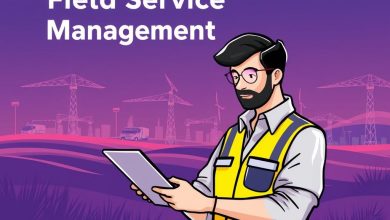Field Service Management with Language-Aware Voice Notes

Introduction
Field Service Management (FSM) is a critical component of modern business operations, particularly in industries such as HVAC, electrical work, plumbing, and home maintenance. As technology continues to advance, FSM solutions have evolved to incorporate innovative features that enhance efficiency, productivity, and customer satisfaction. One such advancement is the integration of language-aware voice notes into FSM systems.
Language-aware voice notes revolutionize how field technicians capture and document information during service calls. This feature allows technicians to speak naturally while the system automatically transcribes their words into text, which is then linked to specific tasks or jobs. This capability addresses several challenges faced by traditional note-taking methods and offers numerous benefits for both technicians and management teams.
- The Evolution of Field Service Management
- Challenges in Traditional Note-Taking Methods
- How Language-Aware Voice Notes Address These Challenges
- Real-Time Transcription
- Automatic Tagging and Contextual Information
- Multilingual Support
- Improved Data Accuracy and Retrieval
- Implementation and Benefits of Language-Aware Voice Notes in Field Service Management
- Enhanced Efficiency
- Improved Customer Satisfaction
- Better Decision Making
- Compliance and Audit Trail
- Scalability and Future-Proofing
- Conclusion
The Evolution of Field Service Management
Field Service Management has come a long way since its inception. From paper-based scheduling systems to sophisticated software solutions, the industry has witnessed significant transformations over the years. Modern FSM platforms offer a wide range of features designed to streamline operations, improve communication, and enhance overall performance.
Key components of contemporary FSM systems include:
- Scheduling and dispatching tools
- Mobile apps for field technicians
- Customer relationship management (CRM) capabilities
- Inventory management features
- Reporting and analytics dashboards
The integration of language-aware voice notes represents the latest advancement in FSM technology, addressing long-standing challenges in data collection and documentation during service calls.
Challenges in Traditional Note-Taking Methods
Before the advent of language-aware voice notes, field technicians often relied on traditional note-taking methods such as paper-based logs or basic mobile apps. These methods presented several limitations:
- Inconsistent accuracy: Handwritten notes were prone to errors and difficult to read later.
- Time-consuming transcription: Transcribing audio recordings into text was labor-intensive and time-consuming.
- Limited context: Notes lacked contextual information about specific tasks or jobs.
- Difficulty in searching and retrieving information: Manual indexing made it challenging to locate specific details quickly.
- Language barriers: Technicians working in multilingual environments faced difficulties in accurately documenting information in different languages.
These challenges led to inefficiencies in service delivery, potential miscommunication between technicians and customers, and difficulties in generating accurate reports for management purposes.
How Language-Aware Voice Notes Address These Challenges
Language-aware voice notes address the limitations of traditional note-taking methods by providing real-time transcription, automatic tagging, and seamless integration with FSM systems. Here’s how these advanced notes overcome the challenges mentioned earlier:
Real-Time Transcription
Language-aware voice notes offer instant transcription of spoken words into text. This feature eliminates the need for manual typing or dictation, saving valuable time during service calls. The transcribed text appears alongside the original audio recording, allowing technicians to review and edit their notes immediately if needed.
Automatic Tagging and Contextual Information
Advanced voice note systems automatically tag the transcribed text with relevant metadata, including job numbers, task descriptions, and technician identifiers. This ensures that all recorded information is properly associated with specific service calls and easily searchable within the FSM platform.
Multilingual Support
Language-aware voice notes can detect and transcribe multiple languages in real-time. This capability is particularly beneficial for companies operating in regions with diverse linguistic populations or for international expansion strategies. The system can automatically translate the transcribed text into multiple languages, facilitating better communication between technicians and customers across language barriers.
Improved Data Accuracy and Retrieval
By eliminating manual transcription errors and providing structured, tagged data, language-aware voice notes significantly improve data accuracy and retrieval efficiency. Technicians can quickly access relevant information using natural language queries, reducing the time spent searching through lengthy documents or audio files.
Implementation and Benefits of Language-Aware Voice Notes in Field Service Management
Integrating language-aware voice notes into an existing FSM system requires careful planning and execution. Here’s how organizations can benefit from implementing this technology:
Enhanced Efficiency
Technicians can focus more on delivering quality service rather than spending time on documentation. The ability to speak naturally while the system captures and structures information leads to faster completion of service calls and improved overall productivity.
Improved Customer Satisfaction
With accurate and detailed records of service calls, technicians can provide more informed responses to customer inquiries. This leads to higher satisfaction rates and reduced callbacks due to misunderstandings or incomplete information.
Better Decision Making
Management teams can leverage the rich data captured by language-aware voice notes to make informed decisions about resource allocation, training needs, and process improvements. Analytics derived from these notes can reveal patterns and trends that might otherwise go unnoticed.
Compliance and Audit Trail
The structured nature of language-aware voice notes provides a clear audit trail of all service interactions. This helps ensure compliance with industry regulations and internal policies, reducing the risk of disputes or legal issues related to service documentation.
Scalability and Future-Proofing
As businesses grow and expand into new markets, language-aware voice notes provide a scalable solution that can adapt to changing linguistic demands without requiring significant changes to the underlying system architecture.
Conclusion
Field Service Management has evolved significantly over the years, and the introduction of language-aware voice notes represents a major leap forward in operational efficiency and customer satisfaction. By addressing long-standing challenges in data collection and documentation, these advanced notes enable technicians to focus on what matters most – delivering exceptional service to customers.
As the field service industry continues to embrace digital transformation, language-aware voice notes will play an increasingly important role in shaping the future of FSM. Organizations that adopt this technology early will gain a competitive edge in terms of productivity, customer satisfaction, and data-driven decision making.
While there may be initial concerns about privacy and data security, many FSM platforms now incorporate robust encryption and secure storage protocols to protect sensitive information. As the benefits become more apparent, we can expect widespread adoption of language-aware voice notes across various industries in the coming years.
In conclusion, the integration of language-aware voice notes into Field Service Management systems represents a powerful tool for enhancing operational efficiency, improving customer satisfaction, and driving business success in the modern era of field service operations.


